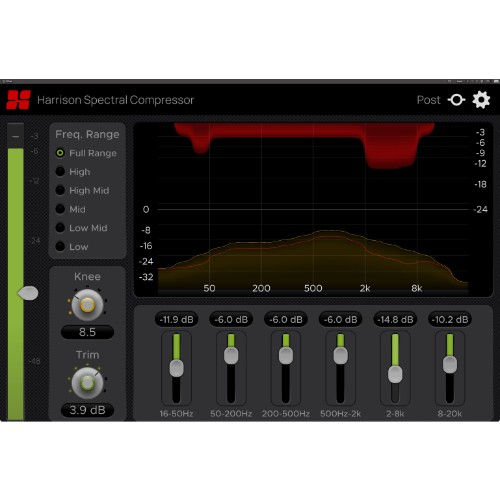
Professionelle Ergebnisse, schnell und einfach!
Der Spectral Compressor ist ein cleverer Dynamikprozessor, der ursprünglich für anspruchsvolle Film- und Postproduktionen entwickelt wurde. Er ist von Harrisons kultigen MPC-Konsolen der Enterprise-Klasse abgeleitet und bietet unvergleichliche Präzision beim Mastering Ihres Mixes. Er bietet 18 Spektralbänder zur Steuerung des Dynamikbereichs, so dass Sie den Klang jedes einzelnen Bandes individuell gestalten oder mit den globalen Reglern den Gesamtklang Ihres Mixes anpassen können. Ganz gleich, ob Sie harte Frequenzen glätten, die Bässe anheben oder die Höhen aufhellen möchten, der Spectral Compressor ist dafür bestens geeignet.
Sie können ihn als effektiven De-Esser, als flexiblen Drum-Bus-Prozessor oder sogar als subtilen Verstärker für Gesang und Instrumente einsetzen. Ganz gleich, in welchem Genre Sie arbeiten, Spectral Compressor verhilft Ihnen zu einem professionellen und verfeinerten Sound.
Features
-
Master Threshold Steuerung
-
Auswahl des Frequenzbereichs
-
Regler für die Bandtiefe
-
Diagramm zur Verstärkungsreduzierung
-
Kompressor-Knie
-
Ausgangstrimmung

Weitere Details in englischer Sprache:
Overview
The Depth sliders below the graph control the maximum amount of gain reduction that can be applied to the corresponding frequency bands determined by the current Range setting. The Range can be set to focus on specific areas along the frequency spectrum (Low, Mid, High, etc.), or it can be set to Full Range mode to allow control over the entire spectrum. The Threshold sets the input signal level where the overall compression begins to take effect. Additional controls include compressor Knee and output Trim.
Controls
Threshold - The slider attached to the input meter on the left is the Threshold control. The Threshold sets the input signal level where the overall compression begins to take effect. The Threshold can be set anywhere between -60 and 0 dB. Frequency Range - The Frequency Range section allows you to select the specific frequency range that gets processed by the compressor. The 18 compressor bands will be distributed across whatever range is selected. For example, with Mid selected, all 18 bands will be focused on the Mid range, allowing for more precise control over the frequencies within that range.
The available Frequency Range options are as follows:
- Full Range, 16 Hz - 20 kHz
- High, 3 kHz - 20 kHz
- High Mid, 200 Hz - 18 kHz
- Mid, 180 Hz - 7 kHz
- Low Mid, 12 Hz - 8 kHz
- Low, 15 Hz - 500 Hz
Depth Controls
The 6 sliders below the graph set the Depth for their corresponding bands. The 18 compressor bands are divided among the 6 sliders so that each slider controls the Depth for 3 of those bands.
The range of frequencies affected are shown below each slider.
The Depth determines the maximum amount of Gain Reduction that can be applied within each slider’s control range. Possible Depth values range from -24 to 0 dB. Setting a Depth slider to 0 dB will prevent any attenuation from occurring within that slider’s control range.
Knee
The Knee value determines how far the input signal must exceed the threshold in a given band, to incur the full depth for that band. Possible Knee values range from 1 to 30. With a low Knee value (Hard Knee), the compression will activate more abruptly as the signal passes over the Threshold. A high Knee value (Soft Knee) will apply the gain reduction more gradually as the signal passes the threshold.
Output Trim
The Output Trim adjusts the level of the compressor’s output signal anywhere from -10 dB to +10 dB. It can be used to increase or decrease the output level as needed for gain compensation.
Gain Reduction Graph
Provides a visual representation of Gain Reduction across the frequency spectrum. The Reduction curve (red) is displayed above the Input curve (orange-yellow) indicating the amount of Gain Reduction applied and its location along the spectrum. The red line inside the Input curve indicates the level of the compressed signal relative to the input signal.
Mac:
- macOS 10.9 oder höher
Windows:
- Windows 7 oder höher
Erforderliche Registrierung:
Für die Nutzung von Harrison Consoles Produkten müssen Sie sich beim Hersteller unter www.harrisonconsoles.com sowie bei www.solidstatelogic.com und bei www.ilok.com registrieren, um Ihre Lizenz zu aktivieren.
Dieses Produkt benötigt eine Aktivierung!
Diese kann entweder auf Ihrem Computer (ohne zusätzlichen Hardware) erfolgen oder alternativ auf einem separat zu erwerbenden iLok USB-Dongle. Der iLok USB-Dongle kann an beliebigen Computern angesteckt werden, um die damit geschützte Software auf mehreren Rechnern zu benutzen. Ihre Lizenzen können über den iLok License Manager beliebig verwaltet und durch eine zusätzliche Versicherung (Zero Downtime mit TLC) vor Verlust oder Diebstahl geschützt werden.
Zur Produktaktivierung benötigern Sie eine Internetverbindung auf einem beliebigen Computer sowie einen kostenlosen User-Account auf www.ilok.com.
Bitte prüfen Sie beim Software-Hersteller, welche iLok Version mindestens benötigt wird, falls Sie einen Hardware iLok benutzen möchten!



